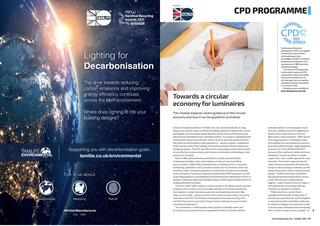


SPONSOR CPD PROGRAMME Towards a circular economy for luminaires Continuing professional development (CPD) is the regular maintenance, improvement and broadening of your knowledge and skills, to maintain professional competence. It is a requirement of CIBSE and other professional bodies. This Journal CPD programme can be used to meet your CPD requirements. Study the module and answer the questions on the final page. Each successfully completed module is equivalent to 1.5 hours of CPD. Modules are also available at www.cibsejournal.com/cpd This module explores recent guidance on the circular economy and how it can be applied to luminaires Driven by the global evidence of climate crisis and, more domestically, by rising energy costs and the impact of inflation on building operation, building users, owners and designers are increasingly appreciating the need to improve effectiveness and reduce the environmental impact of building systems. To succeed in engineering built environments that are more efficient both in terms of resources and performance that will be less detrimental to future generations requires a holistic consideration of the provision of the whole building, not least the luminaires that are employed in the lighting designs. This CPD will reflect on the recent guidance that points towards a more effective circular economy, and introduce an innovative methodology to rate products for circularity. Recent CIBSE publications have outlined the concepts and practicalities of assessing embodied carbon and creating a circular economy for building services systems. CIBSE TM65 Embodied carbon in building services: a calculation methodology, published in 2021, provides an introduction to whole life carbon and embodied carbon, and delivers guidance on actions that can reduce the embodied carbon emissions of mechanical, electrical and plumbing (MEP) equipment. As well as providing guidance on standardised environmental product declarations (EPDs), it includes a method to assess the embodied carbon of MEP products where there is no reliable published information. The 2022 CIBSE TM66 Creating a circular economy in the lighting industry provides a background to circular economy principles and sets out the drivers and barriers to its adoption. It notes that previous practices and models have involved take, make, use and waste a linear economy with no real way of recycling or recovering materials at end of life. The model has developed to incorporate recycling at the end of the line; however, practically, this just results in delaying the point at which luminaires are disposed of. The commentary in TM66 explains that a products embodied carbon and its circular economy performance are separate but linked. A luminaire with low embodied carbon is not necessarily circular economy-capable; however, by adopting the tenets of the circular economy it will very likely reduce carbon emissions. TM65 reports that a large proportion of embodied carbon from building services engineering systems is associated with the product stage (designated as sections A1A3 by BS EN 15978:20111) because of the constituent metals, electronics and plastics involved, as well as a complex supply chain this is wholly apposite for many luminaires. This product stage includes the carbon emissions associated with extraction, transport and processing of materials, and the energy consumption used to manufacture the product. The Ellen MacArthur Foundation2 has popularised the pressing need for action, in part with the much-copied butterfly diagram a part of which is shown in Figure 1 that indicates the various paths that may contribute to a products circularity. TM66 notes that a product that is manufactured thousands of miles away, in fossil fuel-powered factories, and air freighted to site may have high [embodied] carbon but, providing it is designed and supported so that it can be reused, remanufactured and repaired, then it may be circular economy-capable. As www.cibsejournal.com October 2022 61 CIBSE Oct 22 pp61-64 CPD 204 Supp.indd 61 26/09/2022 15:50